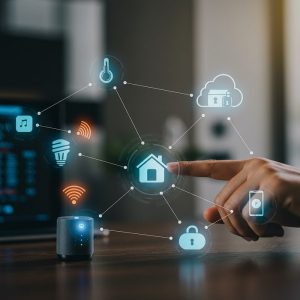The rise of the Internet of Things (IoT) has transformed how we interact with technology, revolutionizing our daily lives. From smart home assistants and connected security cameras to industrial sensors and smart meters, IoT devices have made life more convenient. However, this increased connectivity brings serious privacy concerns that can expose individuals and businesses to cyber threats.
This article explores the risks associated with IoT devices, practical steps to enhance their security, and how I, as a cybersecurity expert, can assist businesses and individuals in securing their smart environments.
Why Privacy is a Concern in IoT Devices
Unlike traditional computers and other gadgets that run operating systems, IoT devices often lack built-in security measures. Most of these devices rely on firmware and rarely receive automatic updates. Many manufacturers prioritize functionality and cost-effectiveness over security, making these devices prime targets for hackers. Here are a few reasons why privacy should be a serious concern for you:
1. Data Collection Without Consent
Many IoT devices collect and transmit personal data, such as smart speakers listening to conversations or smart TVs tracking viewing habits. Users are often unaware of how much data is being stored or shared with third parties.
Example: A smart thermostat might track a homeowner’s daily routine and share this information with advertisers without explicit permission.
2. Weak Authentication and Default Passwords
Many IoT devices come with default passwords that are rarely changed, making them easy targets for hacking. Weak authentication mechanisms can allow unauthorized users to take control of these devices. Example, hackers can exploit security cameras that have unchanged default passwords, gaining unauthorized access to live footage.
3. Unencrypted Communication
Some IoT devices transmit data over the internet without encryption, making it vulnerable to interception. This can lead to man-in-the-middle attacks, where hackers steal sensitive information. For instance, a smart lock that transmits unencrypted access credentials could be intercepted, allowing a hacker to unlock doors remotely.
4. Lack of Regular Updates and Patches
Many IoT devices do not receive regular software updates, which leaves them vulnerable to new exploits and vulnerabilities. Some manufacturers abandon support after a short period, exposing users to long-term risks. For instance, a smart refrigerator running outdated software could be compromised and used as part of a botnet attack.
5. Integration with Other Devices
IoT devices are often connected to home or office networks, making them an entry point for hackers to access more critical systems. A single compromised device can trigger a chain reaction that affects other devices. For instance, a hacked IoT printer in a corporate office could serve as a gateway for accessing confidential business data.
How to Address IoT Privacy Concerns
- Change Default Settings Immediately
— Change default passwords. Ensure you use strong, unique passwords for all IoT devices as soon as you log in to configure them for the first time.
— Disable unnecessary features. Turn off remote access especially unused ports or voice control features if they are not needed. - Enable Strong Authentication Methods
— Use Two-Factor authentication (2FA). If your device supports it, enable 2FA to add an extra layer of security.
— Biometric Authentication is good also. Use fingerprint or facial recognition features if they are available. - Secure Your Network
— Use a separate IoT network. Isolate IoT devices from computers and sensitive data by creating a guest network on your router, some routers supports seperated network for IoT devices, use it.
— Install Firewalls and filter ports. Use a network firewall to filter out unauthorized traffic. - Keep Devices Updated
— Enable automatic updates, though, many IoT devices hardly update automatically. Ensure your devices’ firmware is always up-to-date to patch vulnerabilities.
— Regularly check manufacturer support for security updates. Avoid devices that lack long-term security support. - Encrypt Data and Secure Communication
— Use VPNs for IoT devices especially when transmitting sensitive data. A Virtual Private Network (VPN) adds an encryption layer to prevent eavesdropping.
— Use secure cloud storage. If your IoT device stores data in the cloud, ensure it uses end-to-end encryption. - Monitor and Audit Device Activity
— Set up alerts to increase monitoring efficiency. Get notified when unknown devices connect to your network.
— Review permissions of what is shared. Regularly check what data your IoT devices collect and who they share it with.
How I Can Help as a Cybersecurity Expert
Securing IoT devices involves more than just applying best practices; it requires expert assessment, risk analysis, and customized solutions to protect businesses and individuals from cyber threats. Here’s how I can assist you:
- IoT Security Assessment: I evaluate vulnerabilities in your connected devices and recommend security improvements.
- Network Hardening: I help secure your network infrastructure by setting up firewalls, VPNs, and separate IoT networks.
- Incident Response & Threat Detection: I implement real-time monitoring solutions to detect and prevent cyberattacks on IoT devices for businesses that can support it.
- Employee & User Training: I provide hands-on cybersecurity training for businesses and individuals to ensure best security practices are followed.
- Customized Security Solutions: I tailor security measures based on the type of IoT devices you use, whether at home or in an enterprise setting.
















+ There are no comments
Add yours